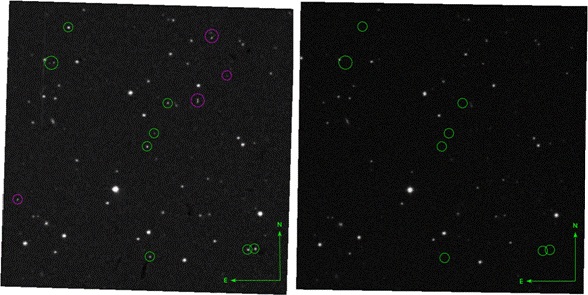An international collaboration of astronomers has identified a curious occurrence of nine stars like objects that appeared and vanished in a small region within half an hour in an old photographic plate.
Astronomers collaborating across counties track vanishing and appearing celestial objects by comparing old images of the night sky with new modern one, register unnatural phenomena, and probe deep into such phenomena to record changes in the Universe.
Scientists from Sweden, Spain, USA, Ukraine, and India, including Dr. Alok C. Gupta, Scientist from ARIES, investigated early form of photography that used glass plates to capture images of the night sky from the 12th of April 1950, exposed at Palomar Observatory in California, USA and detected these transient stars which were not to be found in photographs half an hour later and not traced since then. Such a group of objects appearing and disappearing at the same time have been detected for the first time in the history of astronomy.
The astronomers have not found any explanation in well-established astrophysical phenomena like gravitational lensing, fast radio bursts, or any variable star that could be responsible for this cluster of fast changes in the sky.
Dr. Alok C. Gupta, Scientist from Aryabhatta Research Institute of Observational Sciences (ARIES), Nainital, an autonomous institution of the Department of Science and Technology (DST), Government of India, participated in this study which was recently published in Nature's "Scientific Reports". The study led by Dr. Beatriz Villarroel of Nordic Institute of Theoretical Physics, Stockholm, Sweden, and Spain's Instituto de Astrofísica de Canarias, used the 10.4 m Gran Telescopio Canarias (the largest optical telescope around the world) at Canary Islands, Spain, to do deep second epoch observations. The team hoped to find a counterpart at the position of every object that had appeared and vanished on the plate. The counterparts found are not necessarily physically connected to the weird objects.
The scientists are still exploring the reasons behind the observation of these strange transient stars and are still not sure about what triggered their appearance and disappearance. “The only thing we can say with certainty is that these images contain star-like objects that should not be there. We do not know why they are there,” says Dr. Alok C. Gupta.
The astronomers are examining the possibility that the photographic plates were contaminated with radioactive particles causing false stars on the plates. But if the observation is proven to be real, another option is solar reflections from reflective, unnatural objects in orbit around Earth several years before the first human satellite was launched.
The astronomers who belong to the collaboration Vanishing & Appearing Sources during a Century of Observations (VASCO) have still not sorted out the root cause of the “nine simultaneous transients”. They are now eager to look for more signatures of solar reflections in these digitized data from the 1950s in a hope to find aliens.
Publication link:
https://www.nature.com/articles/s41598-021-92162-7
For more details, Dr. Alok Chandra Gupta (Scientist-F) (+91-7895966668, alok@aries.res.in ) can be contacted.

Figure. The same 10 x 10 arcmin field shown in POSS-1 and POSS-2 red bands. In the POSS-1 image, we see a number of objects that cannot be subsequently found, marked with green circles. Purple circles are artifacts during the scanning process. 9 objects are present in the POSS-I E image (left) from the 12th of April, but not in the POSS-2 image (right) from 1996. One slightly larger circle hosts two transients. The 9 transients are not caused by a difference in depth or spectral sensitivity. The images are based on the DSS digitizations of the Palomar plates.
************
SS/RKP